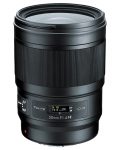Announced
Production status
Original name
System
Pros and cons
Genres or subjects of photography
Recommended slowest shutter speed when shooting static subjects handheld
Nikon AF-S Nikkor 50mm F/1.8G Special Edition
Standard prime lens • Digital era
Abbreviations
| AF-S | The lens is equipped with Silent Wave Motor. |
| G | The lens does not have an aperture control ring and is intended for use on Nikon digital SLR cameras that allow the lens aperture to be adjusted via the camera's command dial. Relays subject-to-camera distance information to the camera, like a D-type lens. |
Model history
| ■Nikon Nikkor-S Auto 50mm F/2 | A | 7 - 5 | 0.60m | ⌀52 | 1959 ● | |
| ■Nikon Nikkor-H Auto 50mm F/2 | A | 6 - 4 | 0.60m | ⌀52 | 1964 ● | |
| ■Nikon Nikkor-H[·C] Auto 50mm F/2 | A | 6 - 4 | 0.60m | ⌀52 | 1967 ● | |
| ■Nikon Nikkor 50mm F/2 | A | 6 - 4 | 0.45m | ⌀52 | 1974 ● | |
| ■Nikon AI Nikkor 50mm F/2 | A | 6 - 4 | 0.45m | ⌀52 | 1977 ● | |
| ■Nikon AI Nikkor 50mm F/1.8 | A | 6 - 5 | 0.45m | ⌀52 | 1978 ● | |
| ■Nikon AI-S Nikkor 50mm F/1.8 | A | 6 - 5 | 0.45m | ⌀52 | 1980 ● | |
| ■Nikon AI-S Nikkor 50mm F/1.8 | A | 6 - 5 | 0.45m | ⌀52 | 1981 ● | |
| ■Nikon AI-S Nikkor 50mm F/1.8 | A | 6 - 5 | 0.60m | ⌀52 | 1985 ● | |
| ■Nikon AF Nikkor 50mm F/1.8 [I] | A | 6 - 5 | 0.45m | ⌀52 | 1986 ● | |
| ■Nikon AF Nikkor 50mm F/1.8 [II] | A | 6 - 5 | 0.45m | ⌀52 | 1990 ● | |
| ■Nikon AF Nikkor 50mm F/1.8D | A | 6 - 5 | 0.45m | ⌀52 | 2002 ● | |
| ■Nikon AF-S Nikkor 50mm F/1.8G | A | 7 - 6 | 0.45m | ⌀58 | 2011 ● | |
| ■Nikon AF-S Nikkor 50mm F/1.8G Special Edition | A | 7 - 6 | 0.45m | ⌀58 | 2013 ● | |
| Nikon AF-S Nikkor 50mm F/1.8G Special Gold Edition (1000 units) | 2014 ● | |||||
Specification
| Optical design: | |
| 50mm | |
| F/1.8 | |
| 35mm full frame | |
| Nikon F [46.5mm] | |
| 46.8° (35mm full frame) | |
| 7 elements in 6 groups | |
| 1 ASPH | |
| On Nikon D APS-C [1.53x] cameras: | |
35mm equivalent focal length: | 76.5mm (in terms of field of view) |
35mm equivalent speed: | F/2.8 (in terms of depth of field) |
Diagonal angle of view: | 31.6° |
| Diaphragm mechanism: | |
Diaphragm type: | Automatic |
Aperture control: | None; the aperture is controlled from the camera |
| 7 (seven) | |
| Focusing: | |
| 0.45m | |
| 1:6.67 | |
Focusing modes: | Autofocus, manual focus |
Autofocus motor: | Silent Wave Motor |
Manual focus control: | Focusing ring |
Focus mode selector: | M/A - M |
Manual focus override in autofocus mode: | Yes |
| Vibration Reduction (VR): | |
| - | |
| Physical characteristics: | |
| 190g | |
| ⌀73×52.5mm | |
| Water-resistant mount | |
| - | |
| Accessories: | |
| Screw-type 58mm | |
| HB-47 - Bayonet-type round | |
| Not compatible |
Source of data
- Manufacturer's technical data.
Manufacturer description
With its updated classic exterior design and feel, outstanding NIKKOR optics and advanced Nikon lens technologies, the AF-S NIKKOR 50mm f/1.8G Special Edition is the perfect match for the Nikon Df and anyone who appreciates the feel of a classic lens. Its fast f/1.8 maximum aperture renders beautifully blurred backgrounds and maximizes low-light performance, and its 50mm normal perspective is ideal for everyday shooting. And despite its classic styling, the AF-S NIKKOR 50mm f/1.8G Special Edition is a fully modern NIKKOR lens with Nikon's advanced technologies, like Silent Wave Motor (SWM) for ultra-fast, nearly silent autofocusing with seamless manual override. Well suited for travel and everyday applications, the AF-S NIKKOR 50mm f/1.8G Special Edition will be your go-to lens for great shots.
The lightweight, compact AF-S NIKKOR 50mm f/1.8G Special Edition is a great travel companion, especially when you need to freeze fast action or if a bright sunny day turns overcast. Its fast f/1.8 maximum aperture makes framing and focusing easier, and allows for high shutter speeds and full exposures under dim lighting conditions.
When shooting wide open at f/1.8, the AF-S NIKKOR 50mm f/1.8G Special Edition renders beautifully blurred backgrounds (bokeh). Make a tack-sharp foreground subject stand out against a softly blurred background, a capability especially well suited for portraits. The lens' 50mm focal length (75mm on DX-format cameras) approximates the angle of view of our eyes, perfect for creating natural perspective in your photographs.
The AF-S NIKKOR 50mm f/1.8G Special Edition is a remarkable blend of classic exterior styling and modern optics and lens technologies. Its focus ring features the easy to grip knurling/hatching from classic manual focus lenses, while its autofocus system uses Nikon's innovative Silent Wave Motor (SWM) for ultra-fast, near silent precision focusing. SWM also allows for seamless manual focus override when fine adjustments are desired. The AF-S NIKKOR 50mm f/1.8G Special Edition will give you years of brilliant performances.
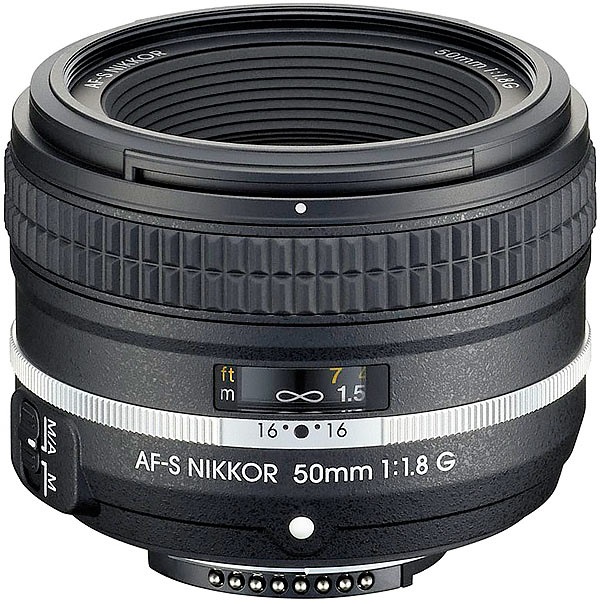
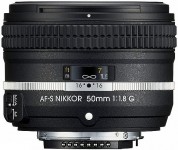
![Nikon AF Nikkor 50mm F/1.8 [I]](https://lens-db.com/wp-content/uploads/2012/10/AF50F18-02-145x150.jpeg)
![Nikon AF Nikkor 50mm F/1.8 [II]](https://lens-db.com/wp-content/uploads/2012/10/43070_6-179x150.jpg)
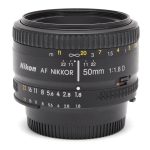
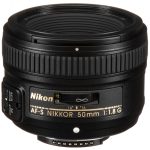
![Nikon AF Nikkor 50mm F/1.4 [I]](https://lens-db.com/wp-content/uploads/2012/10/af-50-14-01-153x150.jpg)
![Nikon AF Nikkor 50mm F/1.4 [II]](https://lens-db.com/wp-content/uploads/2012/10/nikon-af-nikkor-5014-1209-009-130x150.jpg)


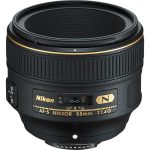
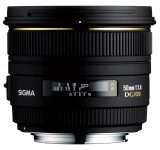
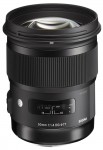
![Tamron SP 45mm F/1.8 Di [VC] USD F013](https://lens-db.com/wp-content/uploads/2015/09/1441200932000_1183050-150x150.jpg)
